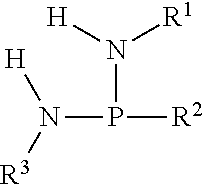Reaction methods for producing nitrogenous phosphoryl compounds that are in situ fluid compositions
a technology of nitrogenous phosphoryl and reaction method, which is applied in the field of low cost processes for the manufacture of nitrogenous phosphoryl compounds, can solve the problems of limiting the utility of low cost substrates such as urea, health and environmental issues, and the formation of amine chloride salts, and achieves the effect of low cost and low cos
- Summary
- Abstract
- Description
- Claims
- Application Information
AI Technical Summary
Benefits of technology
Problems solved by technology
Method used
Image
Examples
example 1
[0596]51.71 grams PCl3, 37.66 grams THF and 27.54 grams butyl amine were cooled to −20° C. A pre-cooled vessel was purged with N2 and then 18.33 grams of THF and 51.76 grams PCl3 were charged. A reaction vessel was purged with N2 and the 27.54 grams butyl amine, 54.28 grams ammonium carbonate and 18.33 grams THF were charged and mixed keeping temperature below −20° C. by utilizing a chilling bath set at −30° C. The mixture of PCl3 / THF was slowly charged to reaction vessel over a 21 hour period at a rate wherein the temperature was desired to be maintained at a range of −10 to −20° C. while ensuring the off-gassing of carbon dioxide did not lead to excessive foaming. Fluidity of reaction vessel contents was extremely thick causing extreme difficulty in maintaining desired temperature range as the temperature range actually was −5 to 5° C. 67 additional grams of THF were charged in an effort to improve the fluidity of reaction vessel contents, replace THF loss to the reaction vessel's...
example 2
[0598]56.30 grams PCl3, 274.21 grams THF and 29.88 grams butyl amine were cooled to −20° C. A pre-cooled vessel was purged with N2 and then 137.11 grams of THF and 56.30 grams PCl3 were charged. A reaction vessel was purged with N2 and the 29.88 grams butyl amine, 48.62 grams ammonium bicarbonate and 137.11 grams THF were charged and mixed keeping temperature at a range of −10 to −5° C. by utilizing a chilling bath set at −30° C. The mixture of PCl3 / THF was slowly charged to reaction vessel at a rate wherein the temperature was desired to be maintained at a range of −10 to 5° C. while ensuring the off-gassing of carbon dioxide did not lead to excessive foaming. Fluidity of reaction vessel contents was acceptable. Reaction vessel contents were heated to 40° C. to convert butyl ammonium chloride to butyl amine and ammonium chloride and to assist in off gassing CO2 from the ammonium bicarbonate. Reaction vessel contents were cooled to −5° C. and ammonia gas charge sub-surface of reacti...
example 3
[0600]42.24 grams PCl3, 205.73 grams THF and 22.5 grams butyl amine were cooled to −20° C. A pre-cooled vessel was purged with N2 and then 102.87 grams of THF and 42.24 grams PCl3 were charged. A reaction vessel was purged with N2 and the 22.5 grams butyl amine, 44.33 grams ammonium carbonate and 102.87 grams THF were charged and mixed keeping temperature at a range of −10 to −5° C. by utilizing a chilling bath set at −30° C. The mixture of PCl3 / THF was slowly charged to reaction vessel at a rate wherein the temperature was desired to be maintained at a range of −10 to 5° C. while ensuring the off-gassing of carbon dioxide did not lead to excessive foaming. Fluidity of reaction vessel contents was acceptable. Reaction vessel contents were heated to 40° C. to convert butyl ammonium chloride to butyl amine and ammonium chloride and to assist in off gassing CO2 from the ammonium carbonate. Reaction vessel contents were cooled to −5° C. and ammonia gas charge sub-surface of reaction ves...
PUM
| Property | Measurement | Unit |
|---|---|---|
| temperature | aaaaa | aaaaa |
| boiling point | aaaaa | aaaaa |
| temperature | aaaaa | aaaaa |
Abstract
Description
Claims
Application Information
 Login to View More
Login to View More - R&D
- Intellectual Property
- Life Sciences
- Materials
- Tech Scout
- Unparalleled Data Quality
- Higher Quality Content
- 60% Fewer Hallucinations
Browse by: Latest US Patents, China's latest patents, Technical Efficacy Thesaurus, Application Domain, Technology Topic, Popular Technical Reports.
© 2025 PatSnap. All rights reserved.Legal|Privacy policy|Modern Slavery Act Transparency Statement|Sitemap|About US| Contact US: help@patsnap.com



